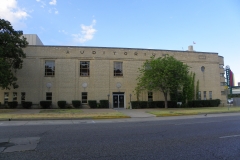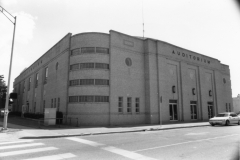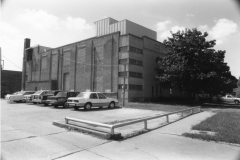| Address: | 220 West Broadway | County: | Carter |
| Started: | 1941 | Completed: | 1943 |
| Agencies: | PWA, WPA | NRHP: | March 8, 2006 |
Current Usage:
Still being used as Auditorium with events scheduled.
Description:
The National Register of Historic Places reads:
Summary:
The Ardmore Municipal Auditorium, is a two-story, blond and red brick, Art Moderne style, rectangular building with a north-south orientation. The building was constructed in 1941-1943 by the Works Progress Administration and incorporated the existing Convention Hall into the new construction. Local architects J.B. and Ben White, who also designed the WPA fairground project, designed the building. The auditorium has combination flat and low-pitched barrel rook with a parapet and a concrete and brick foundation. Various events have been held in the building, beginning with the American Legion’s Bond Rally Boxing Show in January 1943. The Ardmore Municipal Auditorium retains a high degree of integrity. Changes to the building include the addition of two metal penthouses on the roof, cloth awnings on the public entries and front windows, addition of the marquee sign on the northwest corner of the building and replacement of the public doors with modern, aluminum, glazed slab doors. The most notable modification is the addition of the marquee sign that is more Art Deco in style then Art Moderne. The sign, however, does not interfere with the ability of the building to convey its significance. Overall, the auditorium retains a notable degree of integrity, including location, setting, design, materials, workmanship, feeling and association. Although the town of Ardmore was accredited with helping”..Oklahoma achived national oil leadership..” by 1920, as well as reportedly providing fifty percent of all oil used by the Allied powers during World War I with the Healdton oil wells, the depression highly affected the region. Ardmore’s 1920 census shows the community’s population of 14,181 and with the cotton, oil and railroad industries slowing losing revenue the unemployment rate increase dramatically. During the 1930s Great Depression local factories and three of the five local banks closed, as well as four of the five oil refineries. With the advent of President Franklin D. Roosevelt’s New Deal policies and programs some relief was brought to the region and citizens of Ardmore with many WPA projects to assist the unemployed. WPA guidelines required that a “tax-supported public body” sponsor the project which had to result in a permanent and useful addition to the community. These sponsors could be federal, state, or local agencies. The majority of projects were developed by county, city, town and village governments and agencies. The project sponsor provided partial monetary support, usually in the form of land and materials, as well as engineering and architectural plans and specifications.
In August 1940, an advisory committee of 25 leading Ardmore citizens scheduled a meeting with the city commissioners to “launch a program to build a new convention hall and additional permanent buildings at the county fairgrounds.” These amenities were to enhance the available facilities in Ardmore to attract larger conventions and events which in turn would boost the local economy. By October, the proposed plan had grown to include $25,000 (later $15,000) for fire equipment, $20,000 to enlarge and improve the Ardmore airport and $5,000 to erect an extension on the library building. All but the fire equipment bond of the projects to $200,000. The city scheduled a special election for November 26, 1940, to vote on the five bond issues.
The largest bond issue was $60,000 for the purpose of building a new municipal auditorium to hold meetings, conventions, cultural features, entertainment events and rallies. Ardmore’s existing Convention Hall was built in about 1916. The two-story, red brick, modest Italian Renaissance style building had a hip roof with a brick parapet; double, twelve-over-one and eight-over-one, hung windows; multiple, double, wood, glazed paneled doors; and, flat metal awnings over the main entries. Only twenty-four years old, Convention Hall measured just 84 feet by 128 feet with a floor space of 10,572 square feet. The new auditorium was slated to be 110 feet by 146 feet, boosting total floor space to 16,060 square feet. Although only increasing available seating from 3,000 to 3,500, the new auditorium would have better visuals and acoustics with its arena-type seating arrangement. As the roof of the new auditorium was to be supported by steel girders, there would be no need for interior columns obstructing the view. Additionally, the new building called for the removal of the existing wood balcony which was supported by iron columns. Besides the balcony being a fire and safety hazard, the columns supporting the balcony also obstructed the view of the stage from the lower floor. Along with the promise of a safer, fireproof building, voters were tempted with the incentive of proper heating in the winter and an air conditioning service in the summer. 14 Cold weather cast a pall over the bond issue election with early reports noting that at mid-day less than 200 votes had been cast. By the end of day, more than a 1,000 voters exercised their right and all bond issues were passed with more than fifty percent of the total votes in favor. Of the five bond projects, the new auditorium ranked fourth with 629 voting in favor and 403 opposed, leaving a majority of 226. In contrast, the new fire equipment garnered a much larger majority of 686 with 862 supporting the bond and only 176 opposed. It was expected that the County Election Board would quickly certify the vote so the city could begin advertising the bonds by Friday of the same week. Moving rapidly, it was anticipated that the bids would be opened by 12 December 1940 and the money for the projects would be in-hand by mid-January 1941. However, much work remained to be done in finishing the plans and specifications for the two larger construction projects and, importantly, making an application to the WPA. 15 The need to “…have all specifications and details whipped through in record time…” was largely due to the uncertain future of the WPA. Increasing warrelated activities were eroding the demand and available funding for the makework program. Within two weeks of the election, the city commissioners engaged the services of J.B. White, local architect, and his son, Ben, to prepare the design and specifications for the auditorium, fair grounds building and library addition. Although a contract was not signed at that time, it was “…understood…” that the Whites would be given the work. 16 The following week, the selling of the bonds for the Ardmore projects established a new state record for low interest rates for municipal bonds. At a rate of 1.73, the bonds for the municipal auditorium and fairgrounds building were sold to Fenner-Beane of Oklahoma City. Following preparation of transcripts of the sale and printing of the bonds, the matter would then be submitted to the Attorney General for approval. A required thirty-day protest period would then have to elapse before the bonds were delivered to the buyers and the money available to the city. Before construction activity could begin, the city still had to receive WPA approval of the projects to complete the funding. 17 The plans and specifications for the auditorium were submitted to the state WPA office by mid-February 1941. Although the fairgrounds project was approved at the national-level of the WPA in late February 1941, approval of the auditorium did not occur until early April 1941. At that time, the on-going WPA projects in Ardmore, including the drainage ditch, street improvements and construction of the high school gym and office, absorbed all available WPA labor through at least July. With decreasing resources available nationwide for the WPA program, the city was urged to consider choosing one building project to start with. 18 In mid-June 1941, the district WPA administrator, Charles Tompkins, indicated that not all the specifications for the auditorium had been received by the state WPA office. Allowing for the required review process by the state office, the auditorium project would be delayed at least an additional thirty to sixty days. Although the fairgrounds building was cleared to start by 1 August 1941, the plans for the auditorium were still pushed to allow construction to start on it first. The city commission unanimously voted the convention hall as their first choice at a meeting in late June 1941. A shortage of WPA labor was still anticipated to prevent both projects from commencing at the same time. 19 In a somewhat unexpected turn of events, on 1 August 1941, Clarence Harris, Ardmore city manager, announced that the work orders for both the auditorium and fairgrounds building were on hand with a 7 August 1941 start date for both projects. Within days, the Ardmore WPA office issued work orders to 170 men; 60 men were instructed to begin demolition of Convention Hall and 110 men were sent to dismantle the old fairgrounds grandstand and begin preparation of the fairground building’s foundation. True to the WPA’s maximization of resources, the workmen were instructed to “… salvage every possible bit of material that can be saved” from the Convention Hall and the lumber from the grandstand was to be used as form material for the fairground building’s foundation. As planned, ground was broken on the auditorium project on 7 August 1941 with Clarence Harris and Mayor Quinn Wicker doing their part to dig up the site. 20 Work on both buildings progressed nicely through early September 1941. The opening of bids for some materials and work on both buildings at that time revealed that actual construction costs were running ten to twenty percent higher than the original estimates. By October 1941, the citizens of Ardmore were again asked to vote for a bond issue to complete the city building program. Increased material costs due to war-time demands were blamed for a shortfall of $22,000 for the auditorium and $12,000 for the fairgrounds building. Additionally, $58,000 for the construction of a large indoor arena at the fairgrounds was included. With less than one thousand citizens casting a vote, the new bond issue passed with a majority of 154 votes for the auditorium and just 22 on the fairgrounds project. Moving quickly, the bonds were sold by the end of October 1941. 21 News of the construction project was largely eclipsed in December 1941 with the United State’s formal entrance into World War II. Nonetheless, work on the auditorium building continued through 1942. Throughout the year, the WPA program itself was reduced and increasing pressure brought to bear on nondefense related projects. In December 1942, President Roosevelt ordered the liquidation of the WPA as work relief was no longer deemed necessary. Projects which were not federally-sponsored were to be closed out by completing “…useful units…” and/or by turning the project over to the sponsor for completion. The WPA was to shut down by 1 February 1943 in order to divert all possible funding to defense-related programs. 22 Unlike the fairgrounds building which was heavily delayed by the arena addition, the city auditorium was nearly complete before the WPA’s terminating deadline. By early January 1943, finishing touches to the building were inprogress, including installing curtains, drapes and other stage equipment. One feature of the building that was apparently delayed until the end of the war was an amplifying system. Just weeks before the WPA’s final demise, the auditorium was accepted for use by the city. The first event held in the new city auditorium was the American Legion’s Big Bond Rally Boxing Show on 26 January 1943. 23 The Ardmore Municipal Auditorium is historically significant for its association with the WPA, a critical component of President Franklin D. Roosevelt’s New Deal-era program. Nationally from its inauguration in 1935 to its termination in 1943, the WPA expended more than 10.75 billion dollars on a diversity of projects. An additional 2.8 billion dollars was provided by various sponsors on WPA projects. Almost eighty-nine percent of the WPA expenditure was used for wages, with seventeen percent of the sponsors’ funds spent on labor costs. Approximately 8.5 million individuals nationwide benefitted from WPA employment at one time or another. At the peak of WPA employment in Oklahoma, January 1936, 94,821 persons were toiling “on approved projects. By March 1937, 2,971 projects had been approved with 2,581 of those projects being undertaken by the WPA. At the end of the program in 1943, Oklahoma had received over 185 million dollars from the WPA for a multitude of projects statewide. Sponsors statewide expended almost another sixty million dollars. Combined, the Oklahoma economy was boosted by over 232 million dollars in eight years. The projects represent an investment of more than 415 million hours of manpower earning a total of over 140 million dollars in wages for the state of Oklahoma. 24 The infusion of this much-needed work and money into hard pressed communities relieved the pressure of the unemployed on local, state and national economies. The WPA undertook a number of projects in Ardmore and Carter County, over seven projects with a value of nearly $350/000 being in various stages in 1940-1941 alone. The buildings constructed by the WPA, such as the Ardmore Municipal Auditorium, remain as architectural testimony to the social ills and remedies of the 1930s and early 1940s. These buildings represent the local and national efforts to resist the debilitating effects of the worst depression in American history with a certain fortitude and style. As required by the federal guidelines, all WPA projects were to result in a “permanent and useful addition” to the community. The Ardmore Municipal Auditorium exemplifies this requirement. The auditorium was deemed necessary by the community to enhance available facilities to attract larger conventions and events. Learning from their pre-depression mistakes, Ardmore was diversifying its economic base with amenities that would not only serve residents but also aid the Ardmore economy by bringing non-residents to the community. The auditorium has proven a useful addition to the city as it continues to function as originally intended.
BIBLIOGRAPHY
The Daily Ardmoreite. Ardmore, Oklahoma. 24 November 1940; 26 November 1940; 27 November 1940; 2 December 1940; 6 December 1940; 13 December 1940; 18 February 1941; 27 February 1941; 21 March 1941; 7 April 1941; 5 June 1941; 17 June 1941; 18 June 1941; 19 June 1941; 23 June 1941; 24 June 1941; 27 June 1941; 9 July 1941; 1 August 1941; 5 August 1941; 7 August 1941; 3 September 1941; 9 September 1941; 12 October 1941; 13 October 1941; 15 October 1941; 16 October 1941; 30 October 1941; 4 December 1942; 4 January 1943; 20 January 1943; 21 January 1943; 22 January 1943; 24 January 1943; and, 26 January 1943.
The Daily Oklahoman. Oklahoma City, Oklahoma. 7 January 1940 and 4 June 1940.
Dexter, John. “Ardmore Builds and Grows.” Available in the “Ardmore” Vertical File at the Oklahoma Historical Society Research Library, Oklahoma City, Oklahoma, 4 July 1954.
The Farmer’s Weekly Stroud (Oklahoma) Democrat. 19 February 1937.
Final Report on the WPA Program 1934-1943. Washington, D.C.: U.S. Government Printing Office, 1946.
Gibson, Arrell Morgan. Oklahoma: A History of Five Centuries. 2 nd Ed. Norman, Oklahoma: University of Oklahoma Press, 1991.
The History of Carter County. Fort Worth, Texas: University Supply and Equipment Company, 1957.
McGalliard, Mac. “Pioneer Spirit: The Centennial History of Ardmore.” The Chronicles of Oklahoma 65 (Spring 1987), 76-89.
Oklahoma Historic Preservation Survey. “Final Survey Report: Architectural/ Historic Reconnaissance Level Survey of certain Parts of the City of Ardmore.” Available at the Oklahoma State Historic Preservation Office, Oklahoma City, Oklahoma, 1993.
“Questions and Answers on the WPA.” December 1939. Available in the Vertical Files, Oklahoma Historical Society, Research Library, Oklahoma City, Oklahoma.






Wonderful!! Very well researched and cogently written. My grandfather was J B White. I knew that he was the architect on this project but this is the first time I have seen it set in the context of the Depression/WPA./transition to wartime. Very instructive.!
Thank you for your interest in the website and I appreciate the comments. Although this website is use as a collection of research information to assist my personal endeavor to learn more about this period of Oklahoma history it does have an appeal to others gathering information for their research. I have visited most of the structures in the Ardmore area and have identified that the architectural beauty of these structures show a time period where not only the unskilled laborer was accredited to fine work but the skilled citizens as well are accredited. As Dr. David W. Baird state once “These structures are the poor man’s architecture”